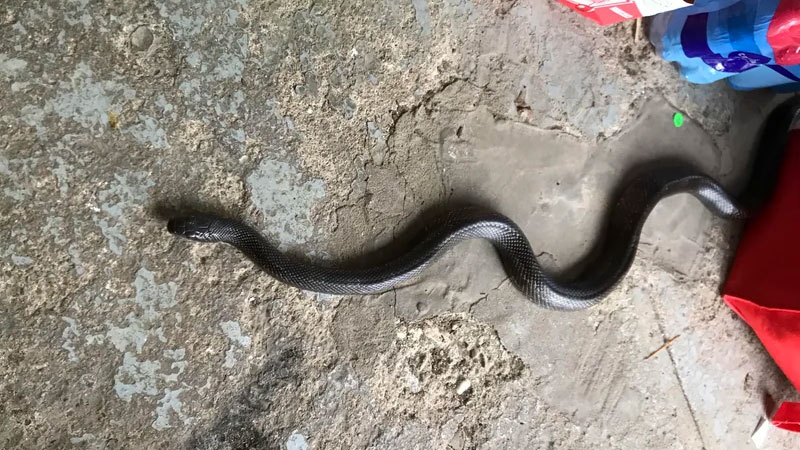Few sensations send a chill down the spine quite like hearing an odd scurry or noise in your basement. While common critters like rodents and raccoons cause enough distress, your imagination can run wild with thoughts of what mysterious creature could be making its home in the shadows below.
All sorts of animals can find a way to sneak in through tiny cracks and gaps—but what exactly shares your subterranean space? Read on to identify what uninvited guest may be lurking under your first floor.
Related: Common Pests Found In Each Area of Your Home
Rodents
Of all the unwelcome critters that can sneak into your underground territory, rodents are unfortunately the most prolific perpetrators.
Being small in stature, they can exploit the tiniest of entry points and gaps in your home’s armor. The scratching, gnawing, and pitter patter of little feet in the basement are dead giveaways that you likely have a mouse or rat problem. Those noises are big reasons why so many people have some sort of fear of mice.
Mice
At only 3-4 inches long, house mice can slip through holes as small as a nickel to gain access inside. They nest in secluded areas and feed on crumbs and food debris that make it downstairs.
Look for small black pellet droppings around their harborage areas. Getting rid of a mouse infestation and preventing their return requires diligent sanitation and sealing up holes in walls.
Related: If You See One Mouse, How Many Do You Have?
Rats
The common Norway rat reaches sizes up to 18 inches including tail length, making it considerably larger than a mouse. What rats lack in size maneuverability though, they make up by chewing directly through structural weaknesses. Drywall, wood, cement, and other building materials are no match for rats’ strong teeth.
Listen for gnawing and scratching noises. Eliminating access to indoor food and extensive exclusion repairs are needed to keep rats out.
Snakes
While less common than mammals setting up camp downstairs, snakes can occasionally find their way inside your basement too.
These elusive reptiles enter through cracks in the foundation or dig under exterior walls to access cooler, damp subterranean areas to meet their habitat needs. Different snake varieties have different tendencies when it comes to how and where they may sneak inside.
Here are three common snake types (all harmless), but other more dangerous snakes such as rattlesnakes and copperheads are a possibility although unlikely.
See Also: Do Snakes Have Bones?
Garter Snakes
One of the most widespread snakes in North America, garter snakes thrive in moist areas outdoors but may venture into basements in search of food. Typically they follow the trails of their rodent prey.
Look for their thin striped bodies, growing up to four feet long. Sealing the outer perimeter is key to keeping garter snakes out.
Milk Snakes
Another hunter of small mammals, milk snakes hide in cracks and voids in search of nesting areas and meals. Adults can reach lengths similar to garter snakes.
If you spot red/black/yellow bands, it’s likely a milk snake visitor. Like garters, milk snakes usually only pass through briefly while following rodents.
Rat Snakes
Living up to their name, rat snakes infiltrate basements trailing house mice and rats as their favored food. They reside in a range of habitats outdoors and have no problem entering manmade structures.
Rat snakes can grow quite large, up to 7 feet. Fast-moving with blotchy brown patterns when young, they follow mice and rats that serve as their ticket inside.
Wildlife
Raccoons, squirrels, and other wild critters have adapted well to living in proximity to people, though we’d prefer they not get too close for comfort.
These savvy mammals can be quite tricky when it comes to locating ways to enter our homes, with basement access being no exception. The noises signaling their unwelcome move-in are obvious clues to identify and remove them.
Squirrels
The frantic skittering of squirrels running through the walls and ceiling is a familiar and aggravating sound to many homeowners. These nimble climbers chew through wood, plastic, and even metal to gain entry if attracted by smells of food.
They also find easy access through openings where wires meet the house exterior. Listen for scrabbling feet and keep an eye out for small claw marks running up and down. Sealing shut any breaches prevents ongoing issues with squirrels below your living quarters.
See Also: Best Squirrel Traps and Repellents That Actually Work
Raccoons
Clever raccoons know our homes offer tempting sources of their favorite foods, from pet food to unfinished meals we discard. They have no qualms entering basements by undoing faulty latches, pushing through pet doors, or descending uncapped chimneys.
These bandits grow over two feet long tip to tail. Rustling and vocal chirping noises often give away raccoons’ presence. Ensure lids seal trash cans and keep pet doors latched when not in use to keep raccoons out of your basement for good.
Feral Cats
You may be used to pet cats lounging around your home or even the neighbor’s cat in your yard, but discovering an unknown feline face lurking in the basement can still deliver shock.
Feral or stray cats lead tough lives outdoors, excelling at hunting while facing dangers. With no owners, they can smell food or shelter and find clever ways inside, even descending into basements through small holes, pipe gaps or windows they exploit using agile frames.
Once inside basements, feral cats seek havens to hide and nest out-of-sight under steps and furniture. Their sharp meows and glowing eyes emerging from darkness are telltale signs, sometimes accompanied by kittens if a mama cat has a litter.
After removal, sealing all holes cats can fit through and watching for loose windows prevents reentry. Safely trapping cornered cats may require professionals to ensure any nursing kittens are not separated before adoption.
Unlikely (But Still Possible) Animals
While less probable basement dwellers, other critters can at times find their way into a basement (most often while chasing rodents or food residue as motivation).
Opossums – Cat-sized mammals, opossums often follow mice and rats inside through small holes. They freeze and play dead when scared. Seal up all openings to prevent their unwanted entry.
Skunks – Famous for their foul spray defense, skunks dig under stoops seeking denning areas. Clatterings and rustling paired with distinctive black and white fur signal their unwelcome presence. Skunk removal is best left to professionals.
Groundhogs – Also called woodchucks, groundhogs dig long dens that sometimes extend right under homes near foundations. Loud thumping noises reveal their destructive excavating work. Their multiple escape tunnels complicate removal efforts, often requiring one-way exclusion doors installation.
The occasional frog, toad or lizard may appear after hitching a ride indoors via plants or firewood. But mammals make up the majority of unplanned basement cohabitants.
Other – See below.
Identifying the Animal
Determining exactly which uninvited creature has made itself at home in your basement takes some detective work. The most common giveaways providing clues to properly ID the pest are:
Droppings, Nests, and Food Remnants
The size, quantity, location, and composition of animal droppings provide critical clues. Mouse poop appears as rice-sized black pellets while rats produce larger, spindle-shaped feces.
Snakes poop contains fur and bones of consumed prey. Nesting materials, food debris trails, and damage to interior structures also help decipher the culprit.
Sounds
Noisy pests practically announce their presence if you listen closely to scratchings in walls, skittering feet, vocalizations, or heavy thuds. Record audio or taping ducts to amplify sounds can help determine if it’s squirrels, raccoons, rats or other animals causing a stir.
Sightings
Actually laying eyes on the trespasser obviously seals the deal for positive ID. Brief nighttime flashlight investigations while quiet may offer a glimpse. Trail cameras, night vision or motion-activated tools often capture images to name which brand of varmint has invaded your property.
Figuring out your exact basement critter before removal allows for appropriate sealing repairs, cleaning measures and prevention tactics tailored to that species of animal interloper. Don’t hesitate calling in experts for humane capturing and releasing guidance if needed.
Most Likely Entryways Into Basement
Take your time when looking for possible entry points, starting at the foundation level. Carefully look at things like gaps around foundation level vents, utility lines, and pipes where they enter the house.
Open floor drains, gaps in siding or brick, broken basement windows, damaged window frames, damaged or open hatches and cellar doors, damaged or missing foundation level vent covers, loose siding, or gaps under doors are all possibilities. Once inside, you may find some animals taking refuge in the basement’s drop ceiling.
If you still can’t find an entry point after looking around the foundation level, it’s possible an animal came from higher up. First, check to see if you have an uncapped or open furnace flue. Anything that can fit in a furnace flue—including a bird, bat, squirrel, or raccoon— can accidently end up in the basement.
If that’s not the culprit, then there’s always a chance an animal came in through your attic/roof and made his way down through the walls.
- How to Identify Skunk Poop (With Pictures) - April 1, 2024
- You Really Don’t Need That Opossum Trap - January 4, 2024
- How to Set a Mouse Trap Without Getting Hurt - December 28, 2023







